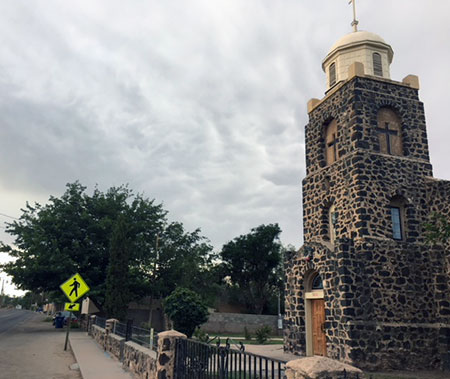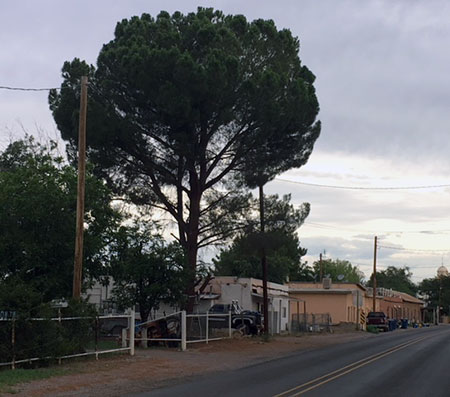By Elizabeth Zach, RCAC staff writer

San Miguel, N. M. – Modest one-story clay homes line the single road that cuts across this community near the U.S. – Mexico border. At first blush, it would seem San Miguel, nestled in the Mesilla Valley, has stood still, or stood the test of time.
Established in the early 1900s, San Miguel resembles other rural communities in this border region. There are no sidewalks here and few businesses, though there is an arresting and prominent stone chapel. Most if not all of the residents work in the surrounding fields as their ancestors did after the United States signed the Mexican Farm Labor Agreement with Mexico in August 1942. That agreement, also known as the Bracero Program, guaranteed decent living conditions, including sanitation, adequate food and shelter, and a 30 cents per hour minimum wage. The program expired in 1964.
The San Miguel community like many others in the area has limited access to basic services, such as water, sewer and housing.
The San Miguel community like many others in the area has limited access to basic services, such as water, sewer and housing. Moreover, official socioeconomic data on the rural community and others like it has typically been scarce, making it difficult for government agencies to obtain federal funding that could improve infrastructure.
San Miguel is a federally designated colonia, which is defined as a rural community with a population of 25,000 or fewer residents and is within 150 miles of the U.S.–Mexico border. Like other colonias, the community struggles to supply residents with a reliable and potable water supply and an adequate sewage system. Colonia residents on average earn a Median Household Income (MHI) of about $26,875 compared with the state average of about $47,000.

“There is a lack of technical, managerial and financial capacity to serve the residents here,” said Olga Morales, a Rural Community Assistance Corporation (RCAC) regional manager for environmental services based in Las Cruces, about 11 miles north of San Miguel. She notes that adequate and sustainable water infrastructure are particularly lacking in San Miguel. “When there are so few residents and water connections, you can’t generate enough revenue to support a staff.”
In San Miguel, 393 water connections serve a population of 1,100 residents. Most of these connections are residential but also include a school and a few businesses.
“And this,” she continued, “is a serious problem especially during times of drought. These communities become very vulnerable to water outages.”
Morales has worked with the Alto de Las Flores Board of Directors since 2011. Alto de Las Flores is a membership-based association that provides drinking water to the community.
The prior year, state funding was set aside to establish the Colonias Infrastructure Project Act, a state program designed to support colonia community infrastructure development, specifically for water systems, wastewater systems, solid waste disposal facilities, flood and drainage control, as well as road and housing infrastructure.
“It was important to put the board back in place to reclaim control of the community,” Morales said.
This enactment was particularly important at the time for San Miguel and how residents there managed their water and wastewater needs. Prior to 2010, Dona Ana County conducted operations and management for Alto de las Flores Mutual Domestic Water Consumers Association (MDWCA). However, in 2011 community residents approached RCAC to request assistance to help them take control again of their water system and, in effect, their community’s future. According to Morales, reclaiming their system was not an easy process as the community lacked the managerial, financial and technical capacity to operate the system. It would take years to eventually sort out and get the community back on its feet. The main challenge was to determine the association’s members and to hold an election to elect a five-member board.
“It was important to put the board back in place to reclaim control of the community,” Morales said.
Since then, work has focused on expanding San Miguel’s local technical, managerial and financial capacity.
On the financial end, Morales and her RCAC colleague Karl Pennock, a rural development specialist, have helped the association improve capacity.
“The Association board members have contracted accounting and billing,” Morales said, adding that MDWCA has no administrative staff. “This frees them to focus on other matters, namely to set policy.”
The board gradually settled on a two-pronged approach. In the short term, Morales worked with the association’s board to enter into contract with the Lower Rio Grande Public Water Works Authority, a regional water system next to the community of San Miguel, which would in turn provide the San Miguel community with a water interconnect for emergency purposes and to provide operation and maintenance services.
While developing the short term solution, Morales also worked with the board to add a large producing well to create and expand its only water source. In terms of infrastructure, the MDWCA members have focused on finishing drilling and developing an existing well, and installing a 250,000-gallon water storage tank. Other improvements include upgrading an undersized distribution line, installing water treatment, and replacing water meters and hydrants. These improvements will enable the system to enhance water quality, meet projected demand, increase operating efficiency, and comply with existing fire code standards.
In August 2017, the association was obligated to $3.367 million in U.S. Department of Agriculture (USDA) funding (including $1.847 million in grants) to complete the long-term infrastructure improvements to its water system. One of the funding conditions required that the association complete a rate study.
In fall 2017, Pennock conducted the water rate study, as Alto De Las Flores board members requested, to meet the USDA loan and grant letter of conditions. The study’s recommendations, presented to board members in March 2018, highlighted significant findings, including that the MDWCA was, as Morales said, not generating enough revenue to meet the requirements of the USDA funding offer.
Specifically, MDWCA would need to be able to make a $61,476 annual loan payment, an annual short-lived $16,000 asset reserve payment, and an annual $6,000 contribution to a debt reserve fund. The study also took inflation into account, along with increases in service connection based on projected population growth.
“I talked with the water operator and the system accountant about the study,” Pennock recalled, noting how important it is to have the board’s support before potentially raising rates. “I also attended board meetings and presented the draft rate study to the board and members of the community in March 2018.”
In short, the study recommended increasing the monthly residential, commercial and base fees so the community could generate positive cash flow to cover all operating and reserve contribution costs to meet the USDA lender requirements.
The board unanimously adopted the rate recommendations and implemented them in May 2018.
Photos taken by Karl Pennock, RCAC rural development specialist.
Reprint: Winter 2018 Rural Matters, rcap.org
